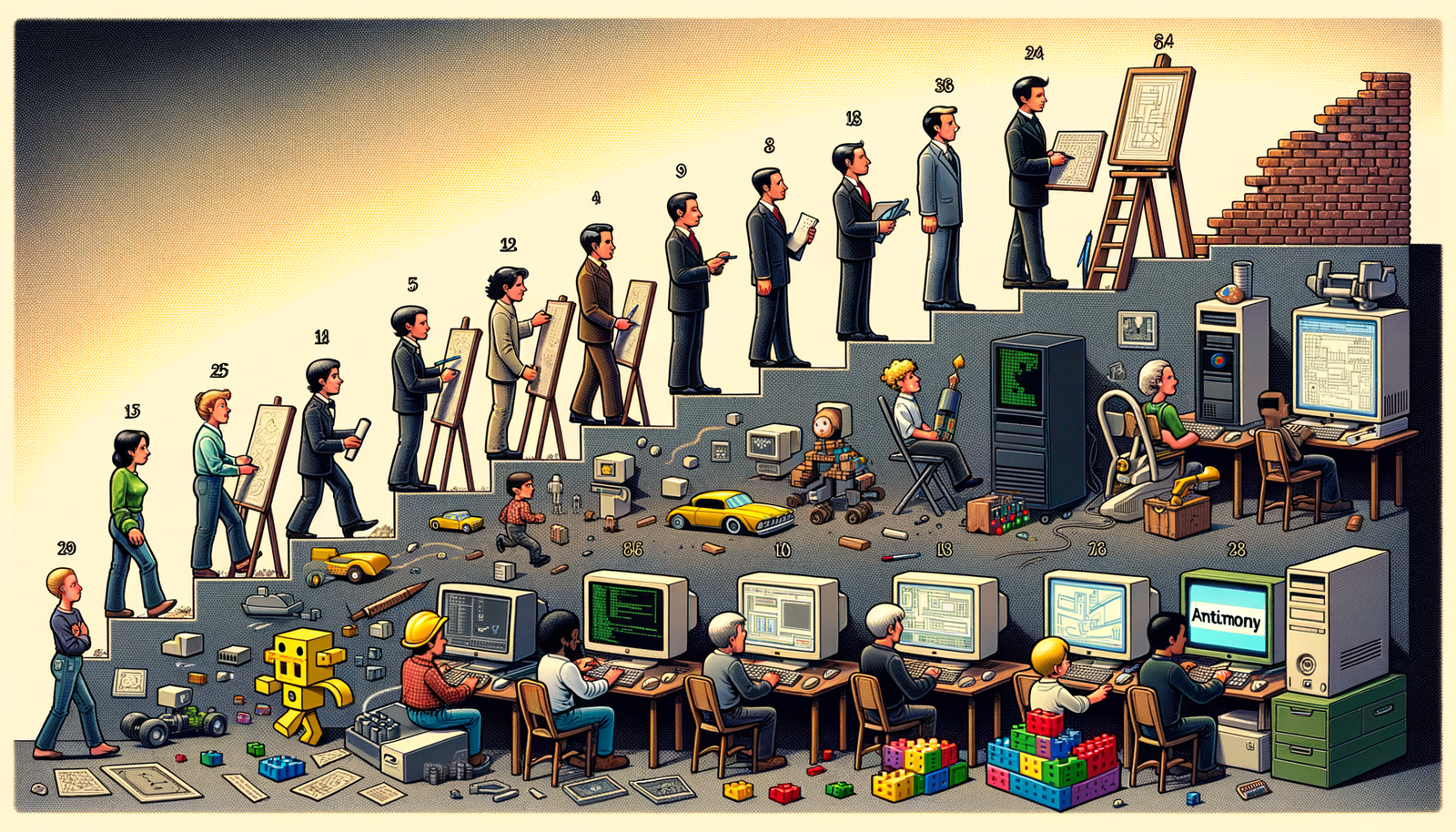Your Cart is Empty
Customer Testimonials
-
"Great customer service. The folks at Novedge were super helpful in navigating a somewhat complicated order including software upgrades and serial numbers in various stages of inactivity. They were friendly and helpful throughout the process.."
Ruben Ruckmark
"Quick & very helpful. We have been using Novedge for years and are very happy with their quick service when we need to make a purchase and excellent support resolving any issues."
Will Woodson
"Scott is the best. He reminds me about subscriptions dates, guides me in the correct direction for updates. He always responds promptly to me. He is literally the reason I continue to work with Novedge and will do so in the future."
Edward Mchugh
"Calvin Lok is “the man”. After my purchase of Sketchup 2021, he called me and provided step-by-step instructions to ease me through difficulties I was having with the setup of my new software."
Mike Borzage
Design Software History: The Evolution of CAD and the Rise of Modular Design with Antimony
May 25, 2024 6 min read


Introduction to CAD and Modular Design
Overview of CAD (Computer-Aided Design)
Computer-Aided Design (CAD) is a pivotal technology in modern engineering, architecture, and various design-based industries. It involves the use of computers to aid in the creation, modification, analysis, and optimization of a design. CAD software enhances the designer's ability to conceptualize designs with precision and efficiency, translating ideas into tangible forms through detailed digital models.
The importance of CAD extends across multiple sectors, including automotive, aerospace, industrial design, and architecture. This software has revolutionized how products are developed and manufactured, providing tools for 2D drawing, 3D modeling, and complex simulations. The core advantage of CAD lies in its ability to offer visualization and iterative capabilities, allowing designers to refine their concepts continuously before physical prototypes are made.
The history of CAD dates back to the 1960s when the first rudimentary systems were developed. One of the earliest instances of CAD technology was the development of the Sketchpad by Ivan Sutherland in 1963, which introduced the concept of graphical user interfaces for design purposes. As technology advanced, so did CAD systems, evolving from simple 2D drafting software into sophisticated 3D modeling tools capable of simulating real-world behaviors and interactions.
Introduction to Modular Design
Modular design is a design principle that divides a system into smaller parts called modules, which can be independently created, modified, and replaced. This approach is widely used in various fields, from software engineering to architecture, due to its inherent flexibility and efficiency.
Principles of modular design emphasize decomposition and reusability. By breaking down a complex system into manageable sub-components, designers can work on individual modules without impacting the entire system. This modularity allows for parallel development, easier troubleshooting, and the ability to update or replace parts without overhauling the whole system.
The benefits of modular design are extensive, including:
- Improved scalability and flexibility
- Enhanced manageability and ease of maintenance
- Cost reduction due to reusability of modules
- Faster development cycles
Applications of modular design are found in various industries. In architecture, for instance, modular buildings can be constructed more quickly and efficiently. In software development, modular code can be reused across multiple projects, significantly reducing development time. This approach also promotes innovation, as individual modules can be experimented with and iterated upon independently.
The Birth of Antimony
Founders and Motivation
The genesis of Antimony, a notable CAD tool for modular design, can be traced back to the collaborative efforts of its founders. The primary individual involved in its creation is Matt Keeter, who envisioned a more streamlined and flexible approach to CAD. Keeter's background in engineering and computational design played a crucial role in the conceptualization and development of Antimony.
The initial vision for Antimony was to create a CAD tool that leveraged the principles of modular design, providing users with an intuitive and powerful platform for developing complex models through simple modular components. This vision was driven by the desire to overcome the limitations of traditional CAD tools, which often relied on rigid and cumbersome workflows.
Development Timeline
The development of Antimony began with a clear roadmap and several key milestones. The early stages focused on establishing the core framework and mathematical models that would underpin the software. Initial challenges included the integration of modular design principles into a user-friendly interface, ensuring that the software remained accessible to both novice and experienced designers.
Key milestones in the development of Antimony include:
- Initial concept and design phase
- Development of core algorithms and mathematical models
- Prototype creation and testing
- Beta release and user feedback collection
- Refinement and final release
Early challenges were addressed through iterative development and close collaboration with a community of users. Feedback played a crucial role in refining the software, addressing usability issues, and enhancing functionality. Overcoming these challenges was pivotal in establishing Antimony as a robust and reliable CAD tool for modular design.
Technical Aspects and Features of Antimony
Core Technology
The core technology behind Antimony is built upon advanced mathematical models and algorithms that enable precise and efficient design workflows. One of the distinguishing features of Antimony is its use of constructive solid geometry (CSG) and graph-based procedural modeling. These techniques allow users to create complex models by combining simple geometric shapes through Boolean operations such as union, intersection, and difference.
Antimony's reliance on procedural modeling sets it apart from other CAD software. This approach involves the use of parameterized modules, which can be easily modified and combined to create intricate designs. The underlying algorithms ensure that these operations are performed with high accuracy and efficiency, providing users with real-time feedback and visualization of changes.
Modular Design Approach
Antimony excels in facilitating modular design through its unique workflow, which emphasizes the creation and manipulation of individual modules. Users can build complex models by assembling and connecting these modules, much like building with digital LEGO blocks. This approach not only simplifies the design process but also enhances flexibility and reusability.
Examples of modular workflows in Antimony include:
- Creating parameterized components that can be easily adjusted and reused in different projects
- Combining multiple modules to form larger assemblies
- Iteratively refining individual modules without affecting the overall design
This modularity allows designers to experiment with different configurations and quickly iterate on their designs, leading to more innovative and optimized solutions. The ease of combining and modifying modules also reduces the learning curve, making Antimony accessible to a broader range of users.
User Interface and Experience
The user interface (UI) of Antimony is designed with simplicity and functionality in mind. The layout is intuitive, featuring a clean design that minimizes clutter and maximizes workspace. Key elements of the UI include a graphical node editor, which allows users to create and manipulate modules through a visual programming interface.
User feedback has been instrumental in shaping the UI and overall user experience (UX) of Antimony. Early adopters provided valuable insights into usability issues and feature requests, which were addressed through iterative updates. The community-driven development approach ensured that Antimony evolved in line with user needs and preferences, resulting in a highly refined and user-friendly CAD tool.
Impact and Future of Antimony
Impact on the CAD Industry
Antimony has had a significant impact on the CAD industry, influencing the development of other CAD software tools and promoting the adoption of modular design principles. Its unique approach to procedural modeling and modular workflows has inspired other developers to explore similar methodologies, leading to a broader acceptance of modular design in CAD.
The adoption of Antimony across various industries has also been noteworthy. Its flexibility and ease of use have made it a popular choice for projects ranging from product design to architecture. The ability to quickly iterate on designs and experiment with different configurations has proven invaluable in fields where innovation and efficiency are paramount.
Future Prospects
The future of Antimony looks promising, with ongoing development and enhancements on the horizon. Upcoming features aim to further streamline the design process, integrating advanced simulation and analysis tools to provide a comprehensive CAD solution. Potential advancements include enhanced support for additive manufacturing, improved interoperability with other design software, and the incorporation of artificial intelligence to assist in design optimization and automation.
These developments have significant implications for the future of modular CAD design. By continuing to push the boundaries of what is possible with modular workflows, Antimony is poised to remain at the forefront of CAD technology, driving innovation and efficiency in design processes across various industries.
Conclusion
In summary, Antimony represents a significant advancement in CAD technology, particularly in the realm of modular design. Its unique combination of procedural modeling, user-friendly interface, and community-driven development has established it as a powerful tool for designers and engineers. The impact of Antimony on the CAD industry is evident, with its principles and methodologies influencing other software tools and promoting a shift towards more flexible and efficient design workflows.
As Antimony continues to evolve, it promises to remain a key player in the future of CAD, offering innovative solutions and pushing the boundaries of what is possible in design and manufacturing. The ongoing development and upcoming features ensure that Antimony will continue to meet the needs of its users, fostering creativity and efficiency in the design process.
Also in Design News

Rhino 3D Tip: Layer States: Save and Restore Layer Visibility and Properties
December 06, 2025 2 min read
Read More
Cinema 4D Tip: Efficient Motion Blur Workflow for Cinema 4D and Redshift
December 06, 2025 2 min read
Read MoreSubscribe
Sign up to get the latest on sales, new releases and more …



